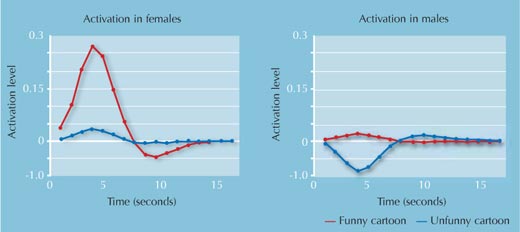The science of humour: Allan Reiss Understand article
Men and women react differently to humour. Allan Reiss tells Eleanor Hayes why this is news.

iStockphoto
Imagine suddenly losing all voluntary control of your muscles, collapsing in a heap on the ground. Being conscious but temporarily unable to move. This is cataplexy, a phenomenon that, in some people, can be triggered by strong emotions. It is also what first got Allan Reiss interested in studying humour in 2002.
Allan, a professor of psychiatry and behavioural science at Stanford University, USA, initially wanted to investigate what happens in the brain when someone suffers a cataplectic attack. He knew that attacks could be triggered by strong emotions such as anger or sexual arousal, but was surprised to learn from a colleague, Emmanuel Mignot, that the most important trigger is humour.
However, before Allan and his team began investigating how humour could induce a cataplectic attack, they needed a baseline – they needed to see how humour affects people in normal circumstances. What happens inside your brain when you find something funny?

iStockphoto
Using advanced brain imaging, it is possible to see inside the head, to measure changes in different parts of the brain. The scientists therefore put healthy volunteers into a functional magnetic resonance imaging (fMRI) machine and showed them cartoons. During the brain scan, the volunteers noted whether they found each cartoon funny or not. Afterwards, they gave each cartoon a score from 0-10 on a funniness scale.
“To create the unfunny cartoons, we took funny cartoons and changed them to spoil the joke. I was fascinated by what very small changes were necessary – changing just one word in the caption could make the difference between a hilarious cartoon and a totally unfunny one.”
When the volunteers saw a funny cartoon, the scientists were able to detect changes to several parts of the brain. In particular, brain regions involved in language and executive processing – organising information – were activated. Given that many of the cartoons had captions, this was not unexpected.
However, Allan and his colleagues wanted to see not only how the human brain reacts to humour, but also whether there were differences in the responses of men and women. They therefore used both male and female volunteers.

Image courtesy of Allan Reiss
So do men and women have a different sense of humour? “Not exactly, no. Men and women rated the same number of cartoons as funny, and they also rated the funniness [0-10] of the cartoons similarly. When we looked at the changes within the brain, though, the picture was rather different.”
When exposed to funny cartoons, women showed higher activity of the language and organisation regions of the brain than men. “That was no real surprise. We know that men and women’s brains are different, and it’s already been shown that, for certain types of task, women use these regions of the brain more than men do.
“What was unexpected was a difference in the mesolimbic reward region of the brain: the funny cartoons stimulated this part of the brain much more in women than in men.” The mesolimbic reward region is associated with happiness: seeing beautiful faces, cocaine-induced euphoria and other ‘positive’ stimuli. “The male and female volunteers said they found the cartoons equally funny, so this difference in brain activity seems to have more to do with their expectations than their actual experiences.”
This could be explained by what are known as dopaminergic neurons – a group of nerve cells that respond not to reward as such, but to the difference between the reward you were expecting and what you actually get. Before the experiments, all the volunteers had been told that they were going to be shown 180 cartoons, only some of which would be funny. It seems that the male volunteers had higher expectations: they expected to be amused. The women, however, were more cautious – and thus, more pleasantly surprised by the funny cartoons. The reactions to the unfunny cartoons also fitted this explanation: the unfunny cartoons caused the mesolimbic reward region of the brain to be deactivated in men (they didn’t get the expected reward), whereas in women there was little or no activity (they were not expecting to be amused; see graph).

Reprinted from Neuron 40(5), Mobbs D et al. Humor modulates the mesolimbic reward centers, 1041-1048, © 2003, with permission from Elsevier
At this point, I can’t resist asking what Allan’s interpretation of the data is. Did the men really have higher expectations than the women? What if they simply didn’t listen to the instructions? With a laugh, he agreed that there are many possible interpretations of the demonstrated differences in brain activation.

iStockphoto
I ask Allan what the next steps will be for him and his colleagues. “We’d like to see how early this gender difference appears, so we’re going to do the same type of experiment with young children, ages six to ten.” In preparation for this experiment, Allan and his colleagues (with the help of lots of young children) have been scouring the online video collection YouTube for funny video clips. The scientists want to look not only for gender differences, but also for differences that depend on the type of reward – does the brain react differently to funny videos (e.g. a child trying to hit a balloon with a stick and accidentally hitting his father) and to other ‘rewarding’ videos (e.g. lots of cute puppies or a child scoring the winning goal in a football match). “It’s been surprisingly difficult to find videos that are not funny but nonetheless equally rewarding in other ways: the children rate humour above anything else we can find,” Allan comments.
I point out to Allan that most of the readers of Science in School teach neither adults nor young children – our readers teach mostly teenagers. If he had a class of 15-year-olds to experiment on, what would he like to find out?
“Puberty is a momentous time. It’s not only the body that’s changing – there are huge changes going on in the brain. And that affects humour too: what a 10-year-old finds funny is very different to what a 16-year-old does. It could be interesting to investigate those changes at the level of the brain.”
Finally, if a class of 15-year-olds wanted to do an experiment on humour at school, what would he recommend?
“Well, they could investigate just that: what sort of humour appeals to different ages. They could give students in each year in their school a choice of cartoons and get them to say which they find funniest. Or ask each class for their favourite jokes and then categorise the jokes into different types of humour and see if this changes with age.”
* * *
Scientific research often leads us off at a tangent; Allan began researching cataplexy and ended up doing rather a lot of research on humour instead. It occurs to me after the interview that I never even asked if he ever did the experiments on humour in cataplectic people. A quick search on the Internet shows that he did, but I’ll let you read that paper for yourselves (Reiss et al., 2008).
References
- Reiss AL et al. (2008) Anomalous hypothalamic responses to humor in cataplexy. PLOS One 3(5): e2225. doi: 10.1371/journal.pone.0002225
- This article, like all articles in PLOS One, is freely available from the journal’s website: www.plosone.org
Resources
- At ESOF, the Euroscience Open Forum, in July 2010, Allan Reiss described some of his research. To watch the video, see the video collection on the ESOF website (www.esof2010.org/webesof) or use the direct link: http://tinyurl.com/3ynca4s
- Azim E et al. (2005) Sex differences in brain activation elicited by humor. Proceedings of the National Academy of Science of the USA 102(45): 16496-16501. doi: 10.1073/pnas.0408456102
- This article is available freely from the journal’s website: www.pnas.org
- Mobbs D et al. (2003) Humor modulates the mesolimbic reward centers. Neuron 40(5): 1041-1048. doi: 10.1016/S0896-6273(03)00751-7
- This article is available freely from the journal’s website: www.cell.com/neuron
- Schultz W (2002) Getting formal with dopamine and reward. Neuron 36(2): 241-263. doi: 10.1016/S0896-6273(02)00967-4
- This article is available freely from the journal’s website: www.cell.com/neuron
- Schultz W, Tremblay L, Hollerman JR (2000) Reward processing in primate orbitofrontal cortex and basal ganglia. Cerebral Cortex 10: 272-283. doi: 10.1093/cercor/10.3.272
- This article is available freely from the journal’s website: http://cercor.oxfordjournals.org
Review
Do men and women react differently to humour? Do boys have a different sense of humour or do girls understand jokes better? This could be an interesting project for students in a biology class. Reading this article should help students to think about possible humour-related differences between the sexes and how they could be studied.
Who would have thought that there is actually a science of humour!
Andrew Galea, Malta





